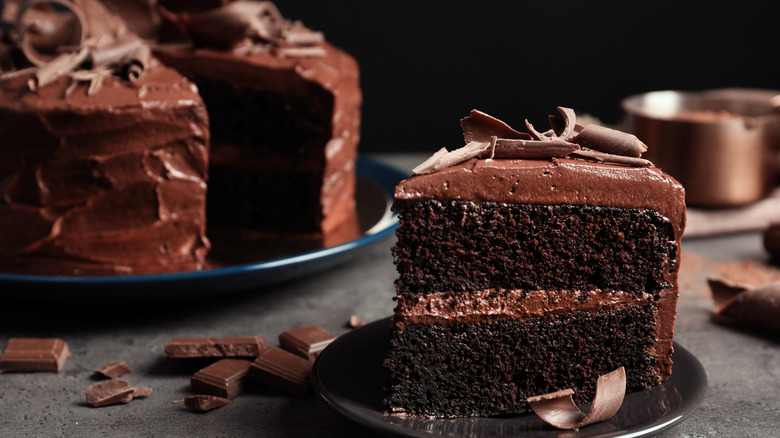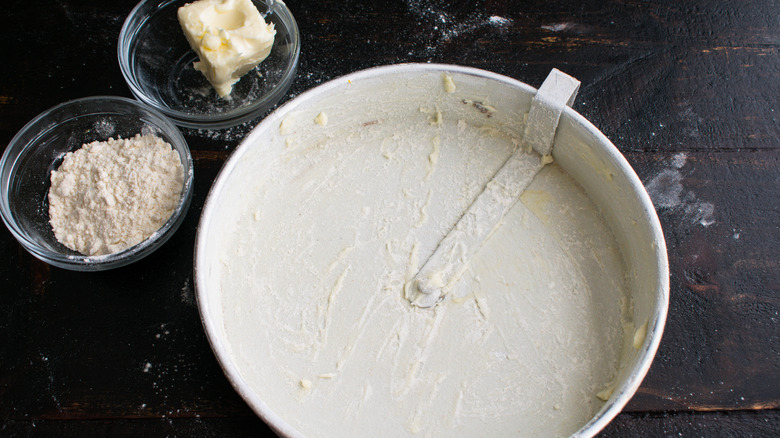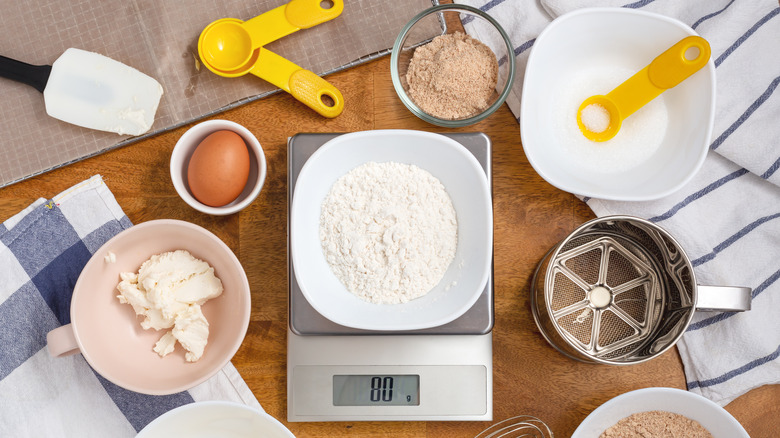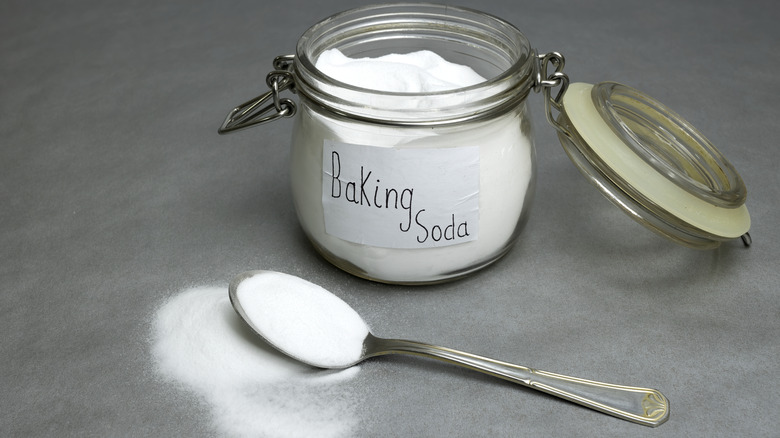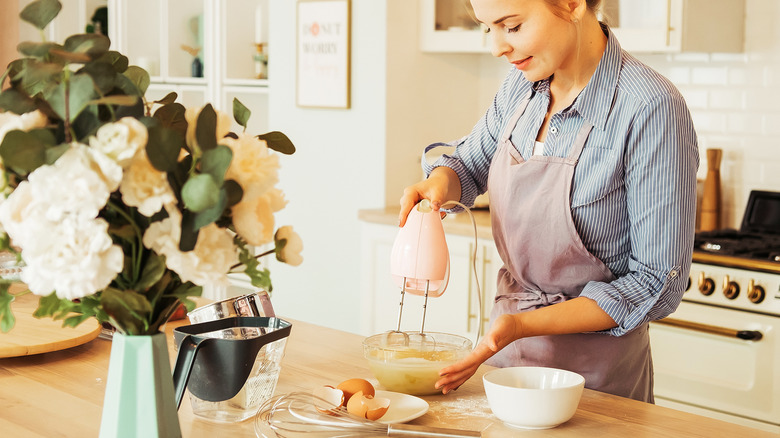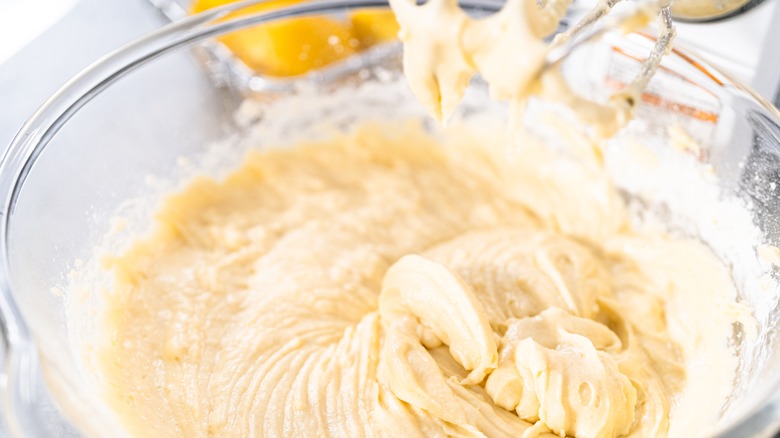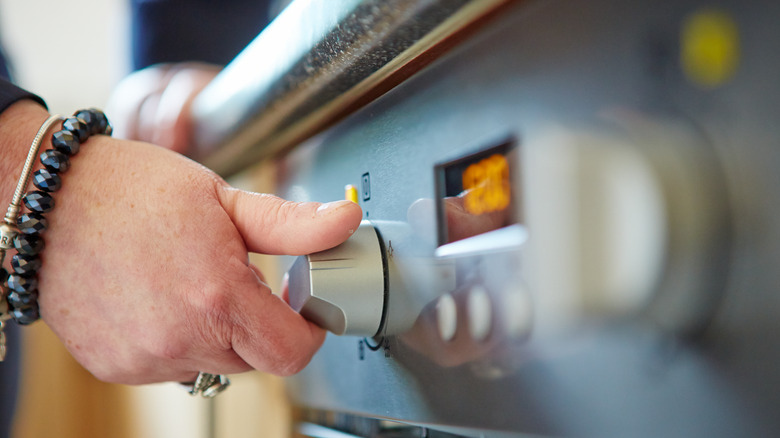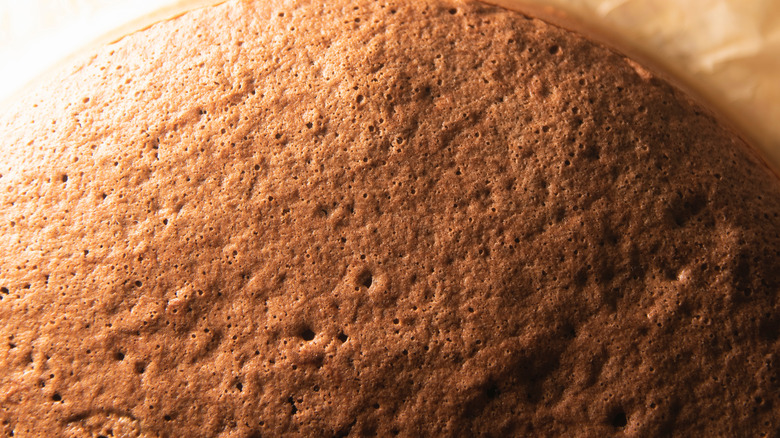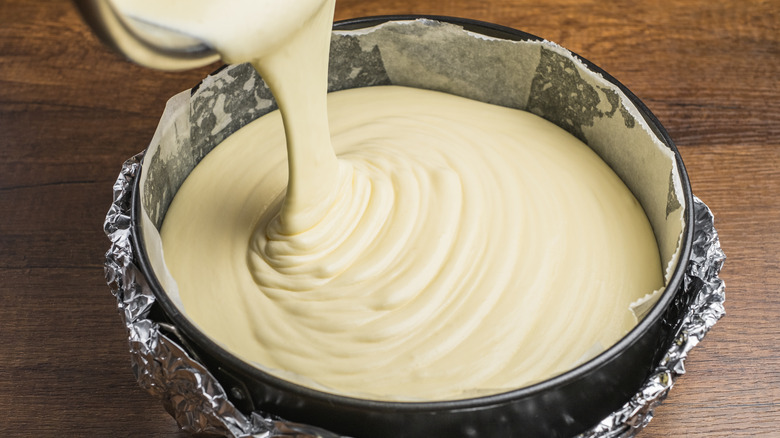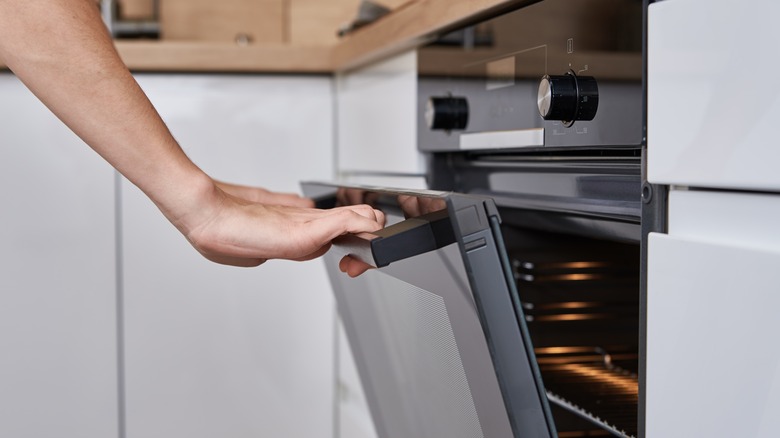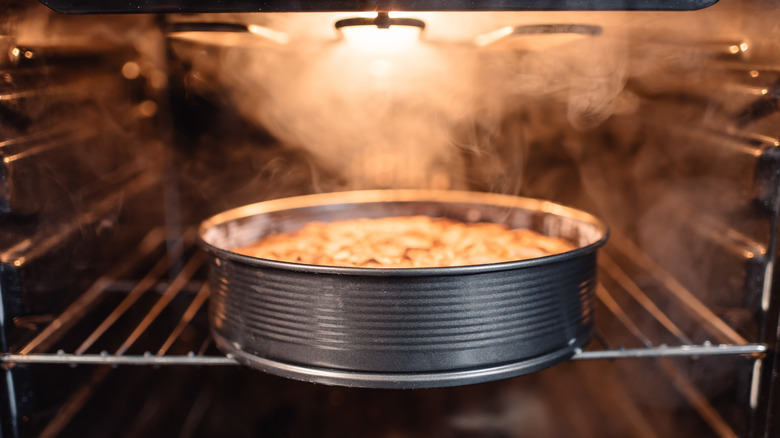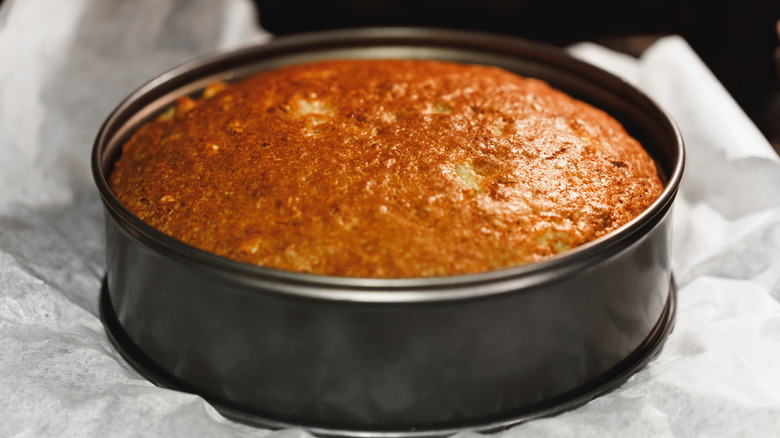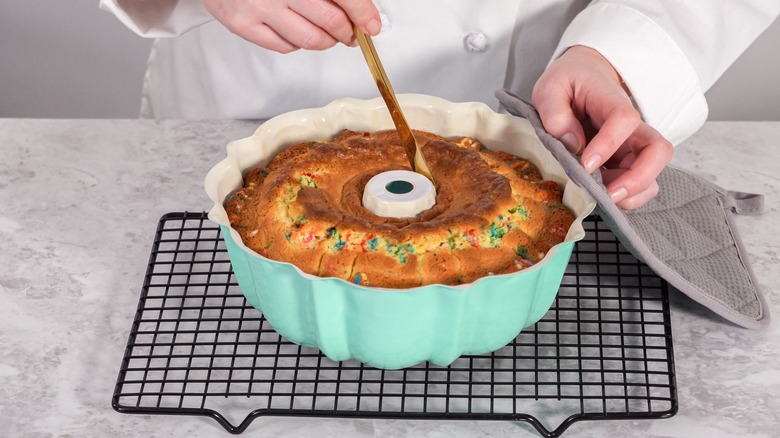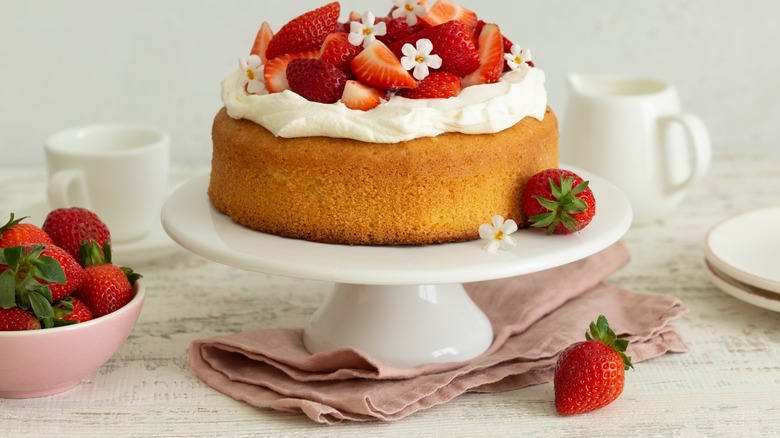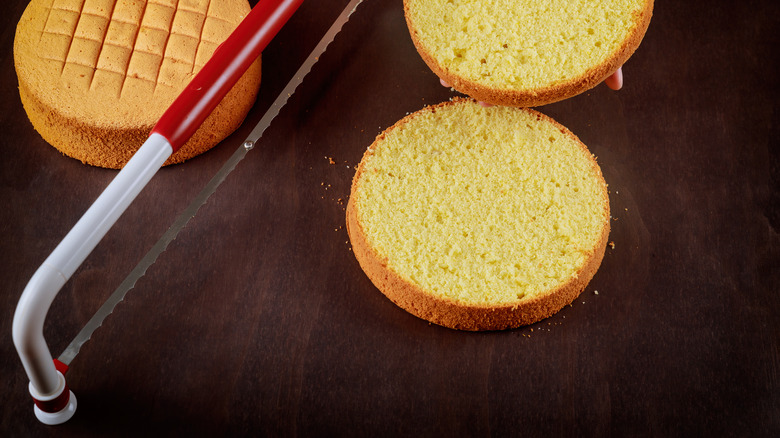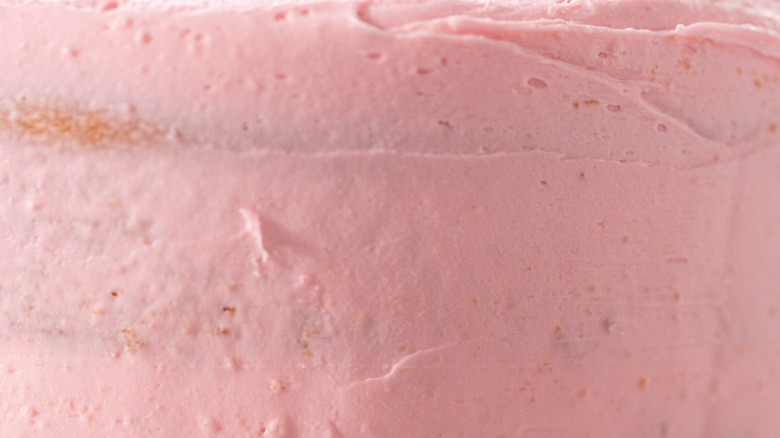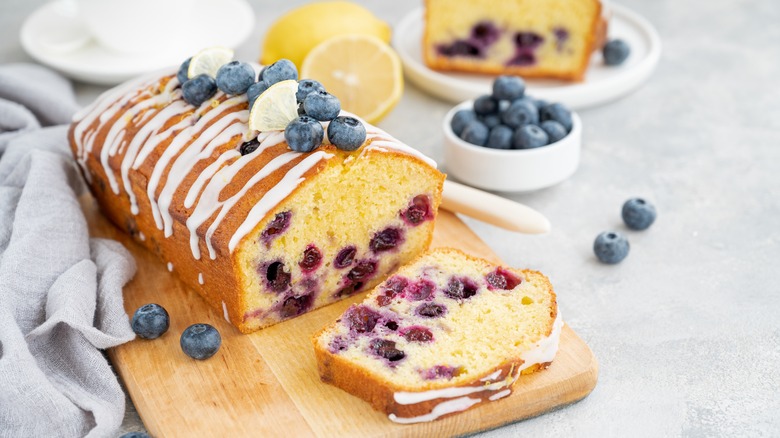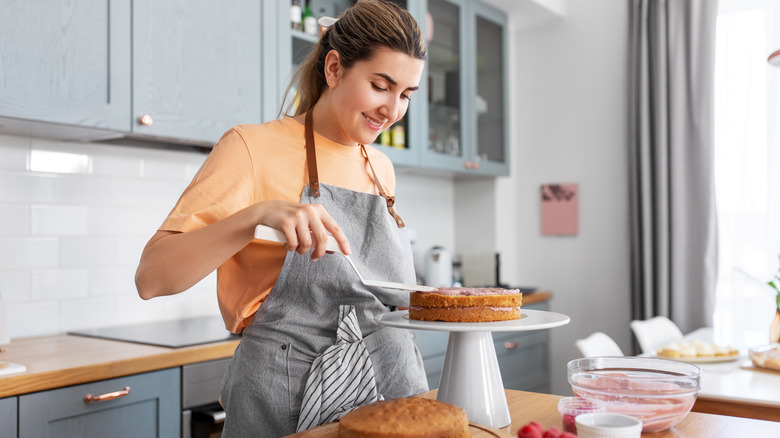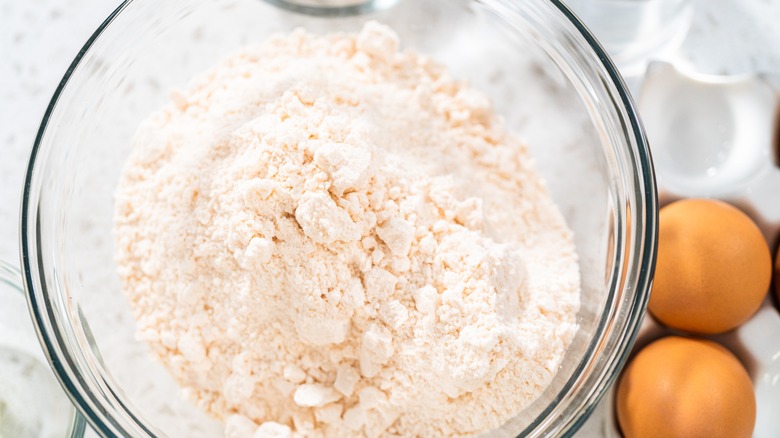20 Mistakes Everyone Makes With Cake
If you consider yourself a "cake enthusiast," you probably have fundamental memories of pouring boxed cake mix into a bowl and having a puff of flour poof up and cover your counters, or decorating your cake only to have half of the icing fall off onto the stand. While you can laugh about those memories now, it was probably hard to make a joke out of it in the moment — especially if the cake you were making was for a special occasion. If anything, these experiences likely taught you that making cake is actually much more difficult than it looks.
If your cake-making skills need a bit of a boost, we're here to help. We've crafted our list to suit many different types of cakes, from a decadent red velvet to a classic bundt. Here are some of the most common mistakes people make with cakes, as well as how to make a top-tier cake that will impress all of your dessert-lovers and eaters.
Not greasing and flouring your pan
If you've worked hard to craft the perfect cake recipe, the last thing you want to do is to have the cake stick to the pan as you take it out. There are a ton of different hacks floating around on the internet to prevent your cake from sticking to the pan. For example, you can coat a pan with a few tablespoons of melted shortening or butter, and put the pan in the freezer for a few minutes to allow it to harden before adding your cake mix.
The Hummingbird Bakery recommends greasing your pan, even if it is labeled as a "nonstick." Southern Living notes that you should also consider dusting the inside of the cake pan with flour after you grease it; the flour makes a protective barrier between the fat and the batter that prevents the two from intertwining during the baking process. That being said, you should always tap the excess flour out of the pan before baking.
Not using the right pan
There are so many different kinds of cake pans out there, so how do you pick the right one? Aluminum oxide pans are a popular material for baking because they are good conductors of heat, durable, and have a semi-nonstick surface that prevents most batters from sticking. Glass pans are less popular because the material does not hold heat as well as metal, but a positive of glass is that it does not impart a metallic taste on the cake (via CNET).
The shape of the pan you use is dependent on what kind of cake you're making. According to Wilton, you should use a springform pan for baking a cheesecake, but not for other liquid cake batters, as the sides of the pan don't have a foolproof seal and could cause the batter to leak out. If you're making a sheet or a layer cake, stick to round or square metal pans.
Approximating your ingredients
Baking is both an art and a science. If you approximate ingredients in your cake recipe, you'll find that your cake is too moist, too dry, doesn't leaven — or some other sort of major fault. You should always bake with a scale because it produces more consistent measurements than measuring cups, or the dreaded "eyeballing" method. For example, if you're measuring brown sugar, you'll get two different weights with hard-packed vs soft-packed sugar. Standardizing your recipes into grams allows you to get the accurate amount of dry ingredients every time. If you're measuring liquid ingredients and are not using a scale, Canadian Living recommends bending down and looking at the measurement straight-on (rather than looking down on it from above), to ensure you are getting the most consistent amount every time.
Using old leavening agents
Although proto-cakes were made from yeast, modern cake recipes are made from leavening agents like baking powder and baking soda (via The Guardian). The baking powder contains both an acid and an alkali that bubbles when it's combined with a liquid. Baking soda, in comparison, requires an acid to kickstart the reaction. The first thing you need to do when you're baking is to check and make sure your leavening agents work. To test baking powder before using it, you should add a teaspoon of baking powder to a cup of hot water. If the solution bubbles within a few minutes, you can use the baking powder with confidence. Most baking sodas expire about six months after opening. If the recipe uses baking soda, try mixing a bit of the powder with lemon juice and wait for a reaction.
Not bringing your ingredients up to temperature
The temperature of your ingredients can have a big impact on your cake. Cold ingredients don't tend to mix together evenly, and an even batter is key to properly-made cake. Room temperature butter, eggs, and dairy emulsify better, and they tend to trap and hold air better than colder ingredients, too (via Sally's Baking Recipes).
You should take your butter out of the fridge about an hour before you plan on baking with it. If you forget to pull your butter out, you can cut it into small cubes to increase the air exposure, thus warming the butter up quicker. Sally's Baking Recipes recommends bringing your eggs up to room temperature by placing them in a bowl of warm (not hot) water for at least 10 minutes before using.
Over or undermixing your batter
Any cake batter can be finicky. If you mix too little, you will have tiny clumps of flour swirling around in the cake when you bite into it. If you overmix your cake batter, you'll over-activate the gluten and cause your cake to develop a tougher, more bread-like texture. You should only mix your cake enough so that the small flecks of flour blend in (via Paste Magazine). A few lumps in your batter are okay, and preferable compared to a stodgy cake.
One of the reasons why people over or undermix batter is because they're using a stand mixer to mix their cake ingredients. With cheesecake, for instance, a stand mixer can reach very high speeds and can cause your cream to split and curdle, which can produce a grainy texture.
Skipping the preheating step
If you look at a cake recipe, you'll see the first step always involves preheating your oven to a set temperature. But, why is preheating so important for your cake? Well, when you don't preheat your oven, you risk an uneven bake.
According to Livestrong, baking a cake at too low of a temperature means that your cake may sink in the middle. If your solution is to extend the time that your cake is in the oven to compensate for the low temperature, the website notes that it may cause your cake to come out too dry. On the flip side, if you increase the temperature too much, you may burn the crust of your cake and potentially cause it to become inedible. It's easiest just to set the oven so it can preheat as you prepare your ingredients.
Leaving air bubbles in your batter
If you've watched professionals on a baking show make a cake, you may see them tap the pan on the counter to release air bubbles. While some air bubbles are important because they indicate that your leavener has worked, too many air bubbles can be detrimental to your cake's texture and will result in a drier cake (via Baking Mad).
To avoid making this mistake, you should tap your cake pan on a counter before placing it in the oven. A couple of quick taps will release the air from the batter and prevent your cake from coming out too dry. This little trick will also help spread out the batter into all the nooks and edges of your pan.
Letting your cake wait too long before you put it in the oven
Time is of the essence when you're making a cake, so why would you waste precious moments and let your cake sit out on the counter before baking? Leaving your cake in a pan for too long before putting it into the oven can impact the texture. According to Nigella Lawson, the precarious mix of leavening agents and eggs in your batter only work for a short period of time. Once the leaveners have been activated, you need to get the pan into the oven as quickly as possible to prevent a deflated or dense cake. Always place your cake into a preheated oven right after you mix the dry and wet ingredients for an optimal rise.
Opening the oven too often during baking
You might be inclined to constantly check on your cake as its baking, but opening and closing your oven constantly can result in the cake getting deflated. If you open and close the oven door when you're baking your cake (particularly if you slam the door), the constant motion may cause your cake to sink in the middle (via Chelsweets). Per Betty Crocker, the rush of cold air into your oven will offset your cooking times, too.
Betty Crocker recommends keeping your oven closed for at least three-fourths of the time it's in the oven. You should also wait five to 10 minutes between opening the oven and checking on your cake again. And if you notice your cake is browning on the top faster than it's cooking inside, use foil to cover the pan and encourage a more even bake.
Not rotating your cake during baking
The only time you should open your oven while baking your cake is to rotate it, as well as to check and see if it's done baking. You should rotate your cake pan only after your cake is two-thirds of the way done. Since the middle of your cake should be finished cooking at this benchmark, you won't have to worry about your cake collapsing in after you rotate it (via Food Network).
The primary reason why rotating your cake is important is because your oven has hotspots. The hottest spots in your oven are the top, bottom, and sides (via King Arthur Baking Company). So, if you place your cake next to a particular wall of your oven, you can expect that side to brown first. Rotating your cake ensures a more even bake.
Taking the cake out of the pan too soon
Your inclination may be to remove your cake immediately from the pan once it's done baking, but MasterClass recommends leaving your cake in the pan for between 20 and 30 minutes to allow the outside of the cake to finish cooking. You want to keep the cake in the pan long enough that it creates a moisture barrier that allows the edges of the pan to loosen (via Real Simple).
If your cake gets stuck to the pan when you try to remove it, you may have forgotten to properly grease your pan. Ashlee Marie recommends running a butter knife on the edge of the cake pan and wrapping it in plastic before placing the entire thing in your freezer. This tip will trap the steam in the plastic wrap and ensure that the moisture barrier is present when you go to remove the cake from the pan.
Cutting into a bundt cake to remove it from the pan
Bundt cakes are always tricky to remove because a bundt pan's intricate crevices open up opportunities for sticking. If you take a knife to your bundt, you're bound to destroy the design and cause pieces of the cake to stay in the pan. If your cake won't come out of the bundt pan, you should layer a dish towel underneath the pan and give it a few gentle (but firm) taps to release the cake (via Reader's Digest). To prevent sticking from happening in the first place, baker Jocelyn Delk Adams recommends making a "cake goop" with equal parts melted shortening, oil, and flour (via Instagram). Brush all the sides of your pan with this mixture to prevent a stuck bundt.
Frosting a warm cake
If you think you're falling behind on making your cake, you might be in a rush to decorate it, but frosting your cake before it is fully cooled can create more problems than you'd think. To make frosting easier, keep your cake moist and cool. Wrap the entire thing in plastic wrap and place it in the refrigerator for a few hours before you start frosting. A cake that has been through this cooling process will be less prone to crumbling when you go to apply your frosting.
Baking Kneads recommends using a cooling rack to expedite the cooling process. Exposing your cake to more air means that it will cool faster. Under the same methodology, you can slice your cake into two pieces horizontally after it has completed its initial cooling in the pan. Be sure to move gently when slicing, though, or you'll end up with raggedy cake.
Not leveling your layers
If you are stacking layers for a layered cake, you'll want to make sure all of your layers are even. One of the important tools you can use for even layering is an aptly named cake leveler, which features a wire connected to a handle that allows you to seamlessly slice across your cake (via Baking Bites).
You can also take precautionary measures to ensure a flat cake exterior. You should cover your cake with a damp kitchen towel after removing it from the oven and place a light weight on top (like a thin cookbook) to encourage the cake to remain moist while also flattening out. Per Rose Bakes, you can also try lowering your oven temperature, since doming is a sign of your oven being set a bit too high.
Not using a crumb coating
Adding a crumb coating to the outside of your cake can help it look smoother. According to Sprinkles for Breakfast, a crumb coat is a thin layer of icing that traps the leftover pesky crumbs that would otherwise stick out and make your cake look disheveled. The crumb coat can also fill in any uneven spots on your cake.
The website recommends first stacking your layers before spreading a thin layer of icing on the sides and top of the cake — working from the top down to the sides. You can use whatever icing you plan to use on the rest of the cake. Then, allow your cake to cool in the refrigerator for about half an hour so the crumb coat can harden. After that, you can frost your cake like normal.
Using cold icing
Everyone who has made a cake before has experienced the horror of putting the icing on right out of the fridge, only to have it stick to the cake in gobs. To avoid a clumpy consistency, you should always use room-temperature frosting when applying it to the cake. Leave it out for about half an hour before putting it on your cake.
On the other end of that spectrum, you want your butter to be solid — not melted — so it forms an icing rather than a soup. If you notice your frosting is runny, you can add a bit of cornstarch to help thicken it up. Leaf TV recommends first grinding your cornstarch to make it extra fine, and then adding a 1/2 teaspoon at a time and mixing until the frosting has thickened.
Using the wrong type of icing for your cake
Everyone knows the staple cake and frosting pairings — like cream cheese icing with red velvet cake or carrot cake — but there are several different types of frosting that you can make to enhance the texture and flavors of your baked goods. Ganache is a frequent pairing for dense chocolate cakes and is made with a 2:1 ratio of chocolate to cream, with the addition of butter for richness (via Bakerpedia).
In comparison, a glaze is a thin icing made with flavoring extracts, powdered sugar, and milk. It's used more frequently for glazing loaf cakes or coffee cakes, mostly because it doesn't have the thickness required to make it pipable. The exact frosting you choose will depend on your flavors and the role you want the icing or frosting to play in the dessert.
Sticking with the same recipe
There are so many baking hacks out there for optimizing moisture and flavor in your cakes. Some of the most unexpected ingredients you can add to a cake are waiting right in your refrigerator or pantry! You can add sour cream to a pound cake to help optimize moisture and impart a slight tang that pairs well with the vanilla flavor. If you want to keep it simple, you can make a two-ingredient cake out of club soda and boxed cake mix. And if you're looking for a decadent spin on chocolate cake, you may consider reaching for your favorite Thanksgiving side — mashed potatoes — for a starchy moisture boost. When it comes to kitchen hacks, always do your research and find recipes that have been tried by multiple outlets. Your favorite new cake recipes are just waiting to be discovered.
Using a low quality boxed mix
Using a low quality packaged cake mix is already setting yourself up for failure. If you're wanting a mix that makes the cut, our favorite brands include King Arthur Baking Company. Their Golden Yellow cake mix just requires you to add butter, eggs, and milk. If you are looking for a low-budget cake mix that doesn't skimp on flavor, Pillsbury is always a widely-accessible option. You can also purchase Pillsbury mixes that are sugar-free or gluten-free, which makes the brand a great option for folks with dietary restrictions. You shouldn't feel shame for purchasing a boxed cake mix — especially when you can add your own frostings, fillings, and ingredients to make it your own — just make sure you're picking a good one.
